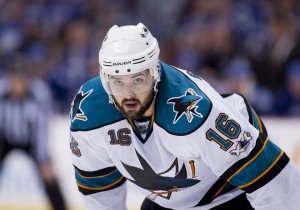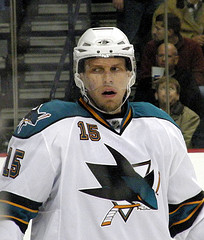Doug Wilson has had a lengthy and largely successful tenure as Sharks general manager. We are coming to the time of year where many of key decisions get made, so it makes sense to look at his work over the years. In addition to the five ‘worst moves’ covered here, there will be a corresponding five ‘best moves’ article.

A franchise does not make the postseason 10 consecutive seasons with a GM that is constantly making major mistakes. If there was a knock on Wilson, it was that he was able to assemble good teams that were never quite good enough in the postseason. The Sharks may have failed to meet expectations, but it has to be noted that the expectation bar was set very high.
When going over the worst moves, many possibilities came up. To make this list, there had to be a significant impact and a big discrepancy between expectation and result. Among the considerations: the rental player trades that never seemed to work out as hoped. Bill Guerin, Craig Rivet and Brian Campbell were all acquired for first round picks, but none of these rentals helped the Sharks past round 2 of the postseason. The traded picks turned into Max Pacioretty, David Perron and Tyler Ennis.
One that did not come close to making the list, but resonates with me, was the arrogant signing of 43-year-old Claude Lemieux in 2008, after a five year absence from the league. From the day the Sharks made that move, it felt like there would be a karmic payback for that sort of arrogance. The Sharks won the President’s Trophy for the most points in the regular season – and they were eliminated in the first round from the playoffs. When you insult the hockey gods, bad things tend to happen.
Also not making the list, some chronic issues. Wilson’s inability to find effective lower line players or draft goalies both come to the fore, but they are collective issues as opposed to individual moves. Signings such as Adam Burish and Michal Handzus were not good ones. However neither move on its own had a major negative impact. I did, however, consider moves that had ‘domino effects’, where one move or choice led directly to another. Some may expect the culture Wilson established to be on this list. It does not make this list for a variety of reasons. Wilson brought in players ranging from Jeremy Roenick and Rob Blake to Scott Nichol and Manny Malhotra. He made several reasonable attempts to improve the culture into one that would be able to win a Cup. If I could cite a specific Wilson move that undermined the culture and any chance for postseason success, I would consider it. No such move exists.
I weighed trades, hirings, firings, draft picks, free agents, players retained, players let go and so forth. Even the letter Wilson wrote challenging the NHL Department of Player Safety regarding their suspension of Raffi Torres was considered. Still, if I missed something, I have no doubt it will get pointed out to me in the comments. The primary theme in the worst list: opportunity knocked in a big way, the GM missed and there were repercussions for a long time. Worth noting, no free agent signings made this ‘worst list’ and none will appear on the ‘best list’. Wilson is averse to signing big names to long-term deals. While there are few free agents in the Wilson era that one can point to as a success, there are also few free agents that one can point to as significant failures.
5. 2007 Draft: Trading Up for Nick Petrecki
When you trade up in a draft, it is because you have a very good feeling about a specific player and their potential. This is especially true when trading up in round 1, where you hope to find your best players. The Sharks gave up 2 second round picks to move up to the late first round in 2007 and get the guy Wilson must have really wanted. At 28th overall, Wilson tapped Petrecki, a defenseman who never did made an NHL impact. On this occasion, patience would have been a virtue. If Wilson had simply waited with his 41st pick, he could have “settled” for an elite defenseman. PK Subban went 43rd in that draft. Some might consider the 2006 draft pick of defenseman Ty Wishart at 16th overall as an even worse move. It was a judgment call. The 2006 draft was very thin. On defense, it was even worse. The +/- leader from defensemen taken in that draft? Eric Gryba at +17. Second best? Ty Wishart at +5. With the Petrecki pick in 2007, Wilson missed out on the chance to select an elite defenseman. There was nothing remotely comparable in the 2006 draft.
4. 2005 Draft: Trading Up for Devin Setoguchi

The 2005 draft was not a particularly strong one, at least once you got past Sidney Crosby and Carey Price, who went first and fifth overall. Still there was talent to be found with the 8th overall pick. Wilson gave up the 12th overall pick plus two later round picks to move up and land Devin Setoguchi. Setoguchi would work out OK for the Sharks. Wilson has had few chances to select in the top 10 and he has needed to make the most of them. Two names stand out that were drafted shortly after Setoguchi. Marc Staal was taken at 12th overall, the Sharks original draft slot. Even worse, Anze Kopitar was taken at 11th overall. Setoguchi would thrive, as many others did, on a line with Joe Thornton. It was a mirage, but it did work out for the Sharks, to a degree. Setoguchi appeared valuable enough to be a key part of the trade that brought Brent Burns to San Jose. The selection of Setoguchi was a missed opportunity for better players. On its own, not enough to make this list. What bumps this to the worst list is that Anze Kopitar wound up with the LA Kings. It is one thing to underachieve on a draft pick, that happens to every GM. It is another thing to see the elite player you didn’t select land with your arch-rival, wreak havoc on your franchise year after year, and hoist multiple Stanley Cups while you don’t have any.
3. 2003 Draft: Trading Up for Steve Bernier
Trading up in round 1 and missing: it seems to be a theme. In Wilson’s first draft as the Sharks GM, he grabbed Steve Bernier after trading up from the 21st overall spot to the 16th spot. Bernier became a modest NHL player. Breaking down the trade into 2 parts, it is apparent that trading up was a great idea. But Wilson had fallen for the wrong guy. Unlike the most drafts, it was actually hard to miss with this pick. While Bernier went at 16th overall, 3 of the next 4 picks turned into major stars. Zach Parise went at 17, Ryan Getzlaf at 19 and Brent Burns at 20. Right strategy, wrong guy. There are 3 missed opportunities I’ve put on this list that all fit a similar pattern. All were involved in Wilson’s trading up in round 1 of the draft. Very reasonably, it could have been: Anze Kopitar, Ryan Getzlaf and PK Subban. What happened: Devin Setoguchi, Steve Bernier and Nick Petrecki. Ouch. For a separate take on the history of the Sharks poorer draft picks, click on this hyper link for my colleague Andrew Bensch’s thoughts.
2. 2009/2011 offseason: Dany Heatley and Martin Havlat trades

In the 2009 offseason, the Sharks sent Milan Michalek and Jonathan Cheechoo to Ottawa for Dany Heatley. Though Heatley would play respectably in San Jose, his play did not live up to his oversized contract and massive salary cap hit. Two years after acquiring him, the Sharks traded him to Minnesota. In return for Heatley, the Sharks got a player the Wild wanted out from under: Martin Havlat. Havlat’s deal included a similar amount of remaining money as Heatley’s, though spread out over a longer time frame. It looked to give the Sharks greater salary cap flexibility, while downgrading from a ‘top 3’ forward talent to ‘top 6’ forward talent. If Heatley underperformed his deal, Havlat was worse, missing considerable time with injury and failing to blend into the team. The Sharks have rarely bought out players, but they did eventually bite the bullet with Havlat. All in all, the original Heatley trade and the domino that followed with Havlat, cost the Sharks well over $30 million, way out of line with the production they supplied.
1. 2014 Offseason and 2014-15 Season: The Debacle
Wilson looked at a team that ended 2013-2014 season with 111 points and a loss in 7 games to the eventual Stanley Cup Champions — and then threw in the towel for the next season. He insulted team leader Joe Thornton. He made a questionable move with his best athlete, Brent Burns. Wilson insisted that players would get a chance to earn a spot, independent of pedigree, but the team did seem to favor pedigree over performance for players like Brenden Dillon and Mirco Mueller. It was “The Year of the Debacle”, essentially a continuous stream of questionable actions emanating from a misguided strategy. Largely as a result of Wilson’s work, the Sharks self-eliminated from this season’s playoffs. While several of the moves Wilson made could be individually considered for this list, it makes sense to group them together, as it was apparently all part of the same plan. There is simply no unpacking one event from the other, this past season stands out as far and away Wilson’s worst work as the GM in San Jose.